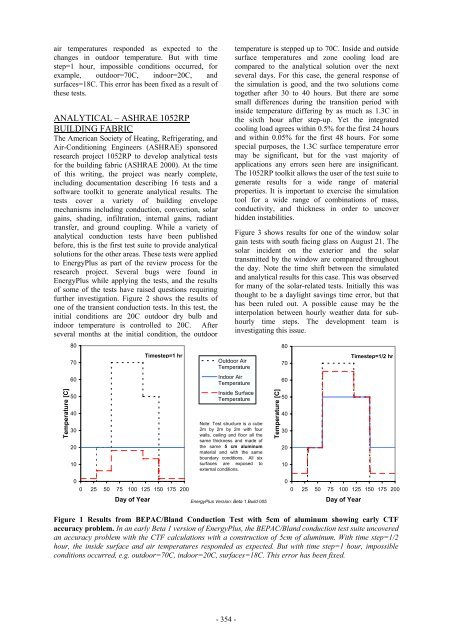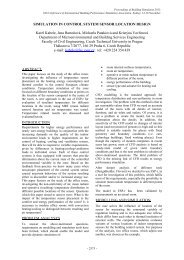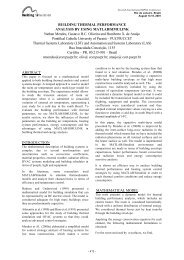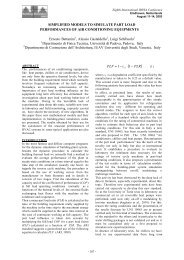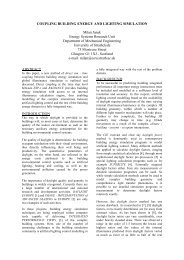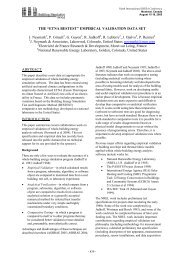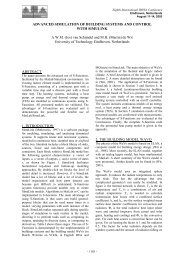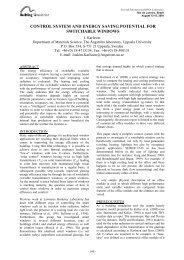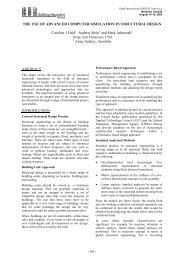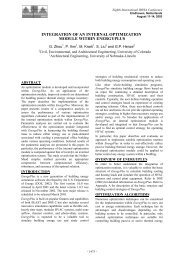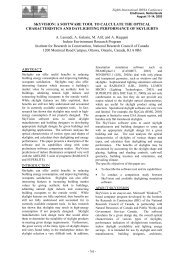testing and validation of a new building energy simulation ... - ibpsa
testing and validation of a new building energy simulation ... - ibpsa
testing and validation of a new building energy simulation ... - ibpsa
Create successful ePaper yourself
Turn your PDF publications into a flip-book with our unique Google optimized e-Paper software.
air temperatures responded as expected to the<br />
changes in outdoor temperature. But with time<br />
step=1 hour, impossible conditions occurred, for<br />
example, outdoor=70C, indoor=20C, <strong>and</strong><br />
surfaces=18C. This error has been fixed as a result <strong>of</strong><br />
these tests.<br />
ANALYTICAL – ASHRAE 1052RP<br />
BUILDING FABRIC<br />
The American Society <strong>of</strong> Heating, Refrigerating, <strong>and</strong><br />
Air-Conditioning Engineers (ASHRAE) sponsored<br />
research project 1052RP to develop analytical tests<br />
for the <strong>building</strong> fabric (ASHRAE 2000). At the time<br />
<strong>of</strong> this writing, the project was nearly complete,<br />
including documentation describing 16 tests <strong>and</strong> a<br />
s<strong>of</strong>tware toolkit to generate analytical results. The<br />
tests cover a variety <strong>of</strong> <strong>building</strong> envelope<br />
mechanisms including conduction, convection, solar<br />
gains, shading, infiltration, internal gains, radiant<br />
transfer, <strong>and</strong> ground coupling. While a variety <strong>of</strong><br />
analytical conduction tests have been published<br />
before, this is the first test suite to provide analytical<br />
solutions for the other areas. These tests were applied<br />
to EnergyPlus as part <strong>of</strong> the review process for the<br />
research project. Several bugs were found in<br />
EnergyPlus while applying the tests, <strong>and</strong> the results<br />
<strong>of</strong> some <strong>of</strong> the tests have raised questions requiring<br />
further investigation. Figure 2 shows the results <strong>of</strong><br />
one <strong>of</strong> the transient conduction tests. In this test, the<br />
initial conditions are 20C outdoor dry bulb <strong>and</strong><br />
indoor temperature is controlled to 20C. After<br />
several months at the initial condition, the outdoor<br />
Temperature [C]<br />
80<br />
70<br />
60<br />
50<br />
40<br />
30<br />
20<br />
10<br />
Timestep=1 hr<br />
temperature is stepped up to 70C. Inside <strong>and</strong> outside<br />
surface temperatures <strong>and</strong> zone cooling load are<br />
compared to the analytical solution over the next<br />
several days. For this case, the general response <strong>of</strong><br />
the <strong>simulation</strong> is good, <strong>and</strong> the two solutions come<br />
together after 30 to 40 hours. But there are some<br />
small differences during the transition period with<br />
inside temperature differing by as much as 1.3C in<br />
the sixth hour after step-up. Yet the integrated<br />
cooling load agrees within 0.5% for the first 24 hours<br />
<strong>and</strong> within 0.05% for the first 48 hours. For some<br />
special purposes, the 1.3C surface temperature error<br />
may be significant, but for the vast majority <strong>of</strong><br />
applications any errors seen here are insignificant.<br />
The 1052RP toolkit allows the user <strong>of</strong> the test suite to<br />
generate results for a wide range <strong>of</strong> material<br />
properties. It is important to exercise the <strong>simulation</strong><br />
tool for a wide range <strong>of</strong> combinations <strong>of</strong> mass,<br />
conductivity, <strong>and</strong> thickness in order to uncover<br />
hidden instabilities.<br />
Figure 3 shows results for one <strong>of</strong> the window solar<br />
gain tests with south facing glass on August 21. The<br />
solar incident on the exterior <strong>and</strong> the solar<br />
transmitted by the window are compared throughout<br />
the day. Note the time shift between the simulated<br />
<strong>and</strong> analytical results for this case. This was observed<br />
for many <strong>of</strong> the solar-related tests. Initially this was<br />
thought to be a daylight savings time error, but that<br />
has been ruled out. A possible cause may be the<br />
interpolation between hourly weather data for subhourly<br />
time steps. The development team is<br />
investigating this issue.<br />
Outdoor Air<br />
Temperature<br />
Indoor Air<br />
Temperature<br />
Inside Surface<br />
Temperature<br />
Note:Teststructureisacube<br />
2m by 2m by 2m with four<br />
walls, ceiling <strong>and</strong> floor all the<br />
same thickness <strong>and</strong> made <strong>of</strong><br />
the same 5 cm aluminum<br />
material <strong>and</strong> with the same<br />
boundary conditions. All six<br />
surfaces are exposed to<br />
external conditions.<br />
Temperature [C]<br />
80<br />
70<br />
60<br />
50<br />
40<br />
30<br />
20<br />
10<br />
Timestep=1/2 hr<br />
0<br />
0 25 50 75 100 125 150 175 200<br />
Day <strong>of</strong> Year<br />
EnergyPlus Version: Beta 1 Build 005<br />
0<br />
0 25 50 75 100 125 150 175 200<br />
Day <strong>of</strong> Year<br />
Figure 1 Results from BEPAC/Bl<strong>and</strong> Conduction Test with 5cm <strong>of</strong> aluminum showing early CTF<br />
accuracy problem. In an early Beta 1 version <strong>of</strong> EnergyPlus, the BEPAC/Bl<strong>and</strong> conduction test suite uncovered<br />
an accuracy problem with the CTF calculations with a construction <strong>of</strong> 5cm <strong>of</strong> aluminum. With time step=1/2<br />
hour, the inside surface <strong>and</strong> air temperatures responded as expected. But with time step=1 hour, impossible<br />
conditions occurred, e.g. outdoor=70C, indoor=20C, surfaces=18C. This error has been fixed.<br />
- 354 -


